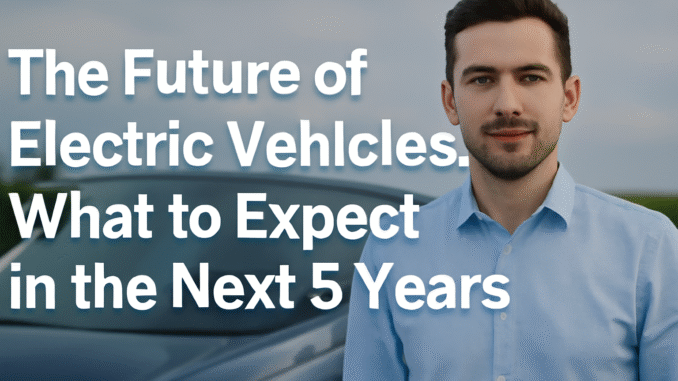
The Future of Electric Vehicles: What to Expect in the Next 5 Years
As we look ahead to 2025, the world is on the cusp of a revolution in transportation, with electric vehicles (EVs) playing a pivotal role in shaping the future of how we drive. Over the past decade, the rise of EVs has been nothing short of transformative. From early adopters to mainstream acceptance, electric vehicles have evolved rapidly, and the next five years promise even more groundbreaking advancements.
With global concerns about climate change, rising fuel costs, and the growing demand for sustainable solutions, the automotive industry is moving toward electrification at an unprecedented pace. In this article, we’ll explore what the future holds for electric vehicles, from cutting-edge technologies to the expansion of infrastructure, and what consumers can expect in the coming years.
1. Increased Range and Faster Charging Times
One of the biggest concerns for potential EV buyers has always been range anxiety—the fear of running out of battery while on the road. While EV range has significantly improved in recent years, there’s still room for innovation. In the next five years, we can expect EVs to be equipped with longer-lasting batteries, allowing for greater ranges on a single charge. Several major manufacturers are already working on solid-state batteries, which promise to be more efficient and lightweight compared to current lithium-ion batteries.
Why it matters: The development of these advanced battery technologies could allow EVs to travel 400-500 miles on a single charge, reducing the concern of running out of battery in the middle of a trip. Additionally, fast-charging technologies will continue to improve, making it possible to charge an EV to 80% in as little as 20 minutes, compared to the current standard of 30-60 minutes.
2. Cost Parity with Gas-Powered Vehicles
While EV prices have been steadily decreasing over the past few years, many still consider them an expensive option compared to traditional gas-powered cars. However, as the cost of battery production continues to drop and economies of scale come into play, electric vehicles are expected to become more affordable. By 2025, many experts predict that EVs will achieve cost parity with internal combustion engine (ICE) vehicles, making them a more accessible option for the mass market.
Why it matters: Achieving cost parity will be a major milestone for the EV industry. Once electric cars become as affordable as traditional cars, we will see a rapid shift in consumer preferences toward EVs. This will lead to widespread adoption, making electric vehicles the standard rather than the exception.
3. A Global Expansion of Charging Infrastructure
The expansion of EV charging stations is one of the key factors that will drive the widespread adoption of electric vehicles. In many regions, the availability of charging stations is still limited, especially in rural areas. However, governments and private companies are investing heavily in expanding charging infrastructure worldwide. By 2025, we expect to see a significant increase in the number of charging stations, making it easier for EV owners to find a nearby charger, no matter where they are.
Why it matters: A robust charging network is crucial for EV adoption. The more charging stations there are, the more convenient and reliable it will be to own an electric vehicle. Additionally, fast-charging networks will likely become more widespread, ensuring that recharging times are minimized and drivers can get back on the road quickly.
4. Integration with Renewable Energy Sources
As the world continues to push for cleaner, renewable energy sources, the integration of EVs with solar and wind power will become increasingly common. In the next five years, we can expect to see more solar-powered EVs, as well as home charging stations that allow consumers to charge their cars using solar energy. These solar-powered charging stations can help reduce the carbon footprint associated with driving an electric vehicle, further supporting the transition to a sustainable future.
Why it matters: The ability to power EVs using renewable energy sources will significantly reduce the overall environmental impact of electric vehicles. Additionally, with the rise of vehicle-to-grid (V2G) technology, EVs could serve as energy storage units that can help stabilize grids and even supply power to homes during peak demand.
5. Autonomous Driving Technology
Autonomous vehicles, or self-driving cars, have been a hot topic in the automotive industry for years. While fully autonomous cars are not yet widely available, significant strides have been made in autonomous driving technology. By 2025, many EVs will feature advanced driver-assistance systems (ADAS), such as adaptive cruise control, lane-keeping assist, and automatic emergency braking. These technologies will pave the way for greater levels of autonomy.
Why it matters: As autonomous driving technology matures, the integration of EVs with self-driving capabilities will offer a safer and more efficient driving experience. With the potential for level 4 or even level 5 autonomy (where the vehicle can drive itself without any human intervention), EVs will offer the convenience of hands-free driving, making long road trips and urban commuting easier and more comfortable.
6. Smart Vehicle Features and Connectivity
As technology continues to evolve, the future of electric vehicles will be increasingly connected. In the next five years, we can expect EVs to become more integrated with the Internet of Things (IoT), allowing them to communicate with smart devices, home systems, and even other vehicles. This means that your car will be able to interact with your smart home, adjusting settings like your thermostat or lighting as you drive home.
Why it matters: These smart vehicle features will create a seamless driving experience that goes beyond just transportation. With enhanced connectivity, drivers can enjoy personalized experiences, such as adjusting climate control based on personal preferences, optimizing routes using real-time traffic data, and even remotely monitoring the status of the vehicle through mobile apps.
7. Environmental Impact and Recycling
One of the biggest advantages of electric vehicles is their environmental friendliness. As more consumers and governments push for sustainable solutions, EV manufacturers will focus on reducing the carbon footprint of their production processes. By 2025, we can expect improvements in battery recycling technologies, which will help reduce the environmental impact of battery production and disposal.
Why it matters: Effective battery recycling will ensure that the materials used in EV batteries, such as lithium and cobalt, are reused, reducing the need for mining and decreasing environmental harm. This will help make electric vehicles even more eco-friendly, aligning with global sustainability goals.
8. EV Adoption Across All Segments
While electric vehicles are currently most popular in the compact and sedan segments, we can expect to see EV adoption expand across all vehicle types in the next five years. From electric trucks to electric SUVs, automakers are working on a wide range of electric models designed to cater to every consumer need. As battery technology improves, larger vehicles like trucks and SUVs will become more feasible for electric powertrains.
Why it matters: Expanding the range of electric vehicles will make EVs more accessible to a wider audience. Consumers who require more space or towing capacity, such as those who need trucks for work, will no longer have to compromise on sustainability.
9. Greater Sustainability in Manufacturing
The automotive industry is increasingly focused on sustainable manufacturing practices. In the next five years, we can expect EV manufacturers to adopt greener production methods, such as using recycled materials, reducing energy consumption, and improving supply chain transparency.
Why it matters: Sustainable manufacturing will make the entire lifecycle of an electric vehicle more eco-friendly. This not only includes the vehicle’s use phase but also its production and disposal phases. As a result, EVs will have a lower overall environmental impact than ever before.
10. Government Incentives and Policy Changes
Governments around the world have implemented various incentives to encourage the adoption of electric vehicles, including tax rebates, subsidies, and grants for EV buyers. Over the next five years, we can expect these incentives to continue evolving, with more governments offering reduced registration fees, free parking, and access to carpool lanes for electric vehicle owners. Furthermore, stricter regulations on carbon emissions will continue to push automakers to accelerate the development of electric vehicles.
Why it matters: Government incentives will play a crucial role in reducing the cost of EVs and encouraging consumers to make the switch from traditional vehicles. As regulations become stricter, more automakers will invest in electric vehicle technology, leading to more choices and lower prices for consumers.
Conclusion
The future of electric vehicles is incredibly exciting. Over the next five years, we will witness incredible advancements in technology, infrastructure, and affordability that will accelerate the shift towards a more sustainable and efficient transportation system. From improved battery range and faster charging times to the widespread adoption of EVs across all vehicle segments, the next five years will shape the future of mobility in ways we can only imagine.
As consumers, we can look forward to driving cleaner, smarter, and more connected vehicles, all while contributing to a healthier planet. With significant strides in technology, policy, and infrastructure, the transition to electric vehicles will be a key pillar in creating a more sustainable and environmentally conscious future.

